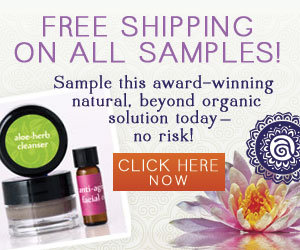I get a lot of questions around which ingredients to avoid. Well, the list is long and plentiful (search any ingredient on the Environmental Working Group’s Skin Deep Cosmetic’s Database) and is likely an inconvenient print out to take with you shopping. However, starting to familiarize yourself with some of the big baddies, is a great start. A rule of thumb I go by is if it takes me effort to pronounce it, it’s probably not good. I use my iPhone for quick ingredient checks on ones I’m not sure about, but for the most part you can figure it out with the use of good judgement.
The picture below says it all. 26 seconds. Every time you put something on your skin (hand cream, face serum, body lotion) just remind yourself where it ends up. Switching to natural is then made that much easier. Below are some of the major “no no” ingredients to help you on a journey to a more healthy and beautiful body.
Isopropyl (SD-40): a very drying and irritating solvent and dehydrator that strips your skin’s moisture and natural immune barrier, making you more venerable to bacteria, molds and viruses. It is made from propylene, a petroleum derivative and is found in many skin and hair products, fragrance, antibacterial hand washes as well as shellac and antifreeze. It can act as a “carrier” accelerating the penetration of other harmful chemicals into your skin. It may promote brown spots and premature aging of skin. A Consumer’s Dictionary of Cosmetic Ingredients says it may cause headaches, flushing, dizziness, mental depression, nausea, vomiting, narcosis, anesthesia, and coma.
DEA (diethanolamine), MEA (Monoethanolamine) & TEA (triethanolamine)
Purpose/Usage: foaming agent
Avoid because: skin sensitizer, can form carcinogenic compounds when mixed with certain cosmetic ingredients, These chemicals are already restricted in Europe due to known carcinogenic effects. In the United States however, they are still used despite the fact that Americans may be exposed to them 10-20 times per day with products such as shampoos, shaving creams and bubble baths.
Products found in: makeup, body wash, shampoo, skincare
How to identify on a label: DEA, Diethanolamine, TEA, Triethanolamine
Phthalates
Purpose/Usage: often used as a carrier for synthetic fragrance
Avoid because: can negatively affect fertility and fetal development, considered a probable carcinogen by the World Health Organizaiton
Products found in: hair spray, lipstick, perfume and nail polish
How to identify on a label: Benzylbutyl phthalate (BzBP), Di-n-butyl phthalate or Dibutyl phthalate (DBP), Diethyl phthalate (DEP), and sometimes Fragrance
Formaldehyde/DMDM Hydantion & Urea (Imidazolidinyl)
Purpose/Usage: an impurity released by some chemical preservatives
Avoid because: carcinogenic, skin and lung irritant, gastrointestinal or liver toxicant and neurotoxin, may cause joint pain, skin reactions, allergies, depression, headaches, chest pains, ear infections, chronic fatigue, dizziness, and loss of sleep. Exposure may also irritate the respiratory system, trigger heart palpitations or asthma, and aggravate coughs and colds. Other possible side effects include weakening the immune system and cancer.
Products found in: nail polish, deodorant, shampoo
How to identify on a label: Formaldehyde, Formalin, Urea, Diazolidinyl urea, Imidazolidinyl urea, DMDM hydantoin, Quaternium-15, 2-bromo-2-nitropropane-1,3-diol, and Sodium hydroxylmethylglycinate
Parabens
Purpose/Usage: synthetic preservative
Avoid because: found in breast tissue, acts like estrogen in the body, could lead to impaired fertility or fetal development
Products found in: soap, skincare, body care, hair care, toothpaste, deodorant
How to identify on a label: alkyl parahydroxybenzoate, butylparaben, methylparaben, ethylparaben, propylparaben, isobutylparabens
Petrolatum
Purpose/Usage: used as an emollient or lubricant
Avoid because: commonly contains impurities linked to cancer
Products found in: skincare, body care, lip balm, makeup
How to identify on a label: petrolatum, petroleum jelly, mineral oil
Propylene Glycol and Butylene Glycol
Purpose/Usage: helps a product to retain moisture
Avoid because: penetration enhancer (alters skin structure, allowing other chemicals to more easily enter the system), They easily penetrate the skin and can weaken protein and cellular structure. Commonly used to make extracts from herbs. PG is strong enough to remove barnacles from boats! The EPA considers PG so toxic that it requires workers to wear protective gloves, clothing and goggles and to dispose of any PG solutions by burying them in the ground. Because PG penetrates the skin so quickly, the EPA warns against skin contact to prevent consequences such as brain, liver, and kidney abnormalities.
Products found in: skincare, hair care, body care, makeup, baby care products, contact lens cleaner
How to identify on a label: Propylene Glycol, Proptylene Glycol, 1,2-Propanediol. Related synthetics: PEG (polyethylene glycol) and PPG (polypropylene glycol)
Polyethylene Glycol (PEG): potentially carcinogenic petroleum ingredient that can alter and reduce the skin’s natural moisture factor. This could increase the appearance of aging and leave you more vulnerable to bacteria. Used in cleansers to dissolve oil and grease. It adjusts the melting point and thickens products. Also used in caustic spray-on oven cleaners.
Sodium Lauryl/Laureth Sulfate
Purpose/Usage: makes a product foamy
Avoid because: penetration enhancer (alters skin structure, allowing other chemicals to more easily enter the system),Animals exposed to SLS experience eye damage, depression, labored breathing, diarrhea, severe skin irritation, and even death. Young eyes may not develop properly if exposed to SLS because proteins are dissolved. SLS may also damage the skins immune system by causing layers to separate and inflame.
Products found in: shampoo, facial cleansers, body wash, bubble bath, baby bath, toothpaste
How to identify on a label: Sodium Laureth Sulfate, Sodium Lauryl Sulfate, Sodium Lauryl Ether Sulfate, Anhydrous Sodium Lauryl Sulfate, Irium
1,4 Dioxane
Purpose/Usage: a chemical by-product of ethoxylation, an ingredient processing method used to make petro-ingredients less irritating to skin
Avoid because: carcinogenic, suspected cardiovascular and blood toxicant, gastrointestinal toxicant, immunotoxicant, kidney toxicant, neurotoxicant, respiratory toxicant, skin toxicant
Products found in: shampoo, facial cleansers, body wash, bubble bath, baby bath, liquid soap
How to identify on a label: because 1,4 Dioxane is a contaminant produced during the manufacturing process, FDA does not require it to be listed on a product ingredient listing. EWG.org recommends looking for common ingredients which may contain the impurity, identifiable by the prefix or designations of ‘PEG,’ ‘–eth–,’ ‘Polyethylene,’ ‘Polyethylene glycol’ ‘Polyoxyethylene,’ or ‘–oxynol–’ (FDA 2007).
Synthetic Colorants (FD&C colors)
Purpose/Usage: coal tar (petroleum) derived and commonly tested on animals due to their carcinogenic properties, used to artificially color a cosmetic product
Avoid because: can cause skin irritation and allergic reactions, Animal studies have shown almost all of them to be carcinogenic.
Products found in: shampoo, facial cleansers, body wash, skincare, baby care products, hair care, makeup
How to identify on a label: FD&C or D&C followed by a name and number (FD&C RED NO. 40)
Synthetic Fragrances
Purpose/Usage: combination of chemical ingredients used to artificially scent a cosmetic product
Avoid because: can cause allergic reactions, headache, dizziness, and rash (children tend to be particularly sensitive), respiratory distress, and possible effects to reproductive system
Products found in: hair care, skin care, makeup, body care, perfume
How to identify on a label: fragrance, parfum (It is important to note that the terms “fragrance” or “parfum” sometimes occur on an ingredient listing which contains natural fragrance ingredients and no chemical ingredients. This is most often due to manufacturer trade secret and should be disclosed on the label.)
Alternative – Organic Essential Oils.
Synthetic Sunscreens
Purpose/Usage: provide sun protection
Avoid because: have been found to mimic estrogen in the body potentially causing hormonal disruption, can also cause skin irritation and easily absorb in to the skin
Products found in: sunscreens, facial moisturizer, lip protection
How to identify on a label: 4-Methyl-Benzylidencamphor (4-MBC), Oxybenzone Benzophenone-3, Octyl-methoyl-cinnamates (OMC), Octyl-Dimethyl-Para-Amino-Benzoic Acid (OD-PABA), Homosalate(HMS)
Methylisothiazolinone (MIT)
Purpose/Usage: widely used as a preservative
Avoid because: possible neurotoxin, possible health risks to unborn babies, allergic reactions
Products found in: hair care, body wash, sunscreen, skin care
How to identify on a label: > 3 (2h) -Isothiazolone, 2-Methyl-; Methylchloroisothiazolinone225methylisothiazolinone Solution; 2-Methyl-3 (2h) -Isothiazolone; 2-Methyl-4-Isothiazolin-3-One; 2-Methyl- 3 (2h) -Isothiazolone; 2-Methyl-2h-Isothiazol-3-One; 3 (2h) Isothiazolone, 2methyl; 2-Methyl-3 (2h) -Isothiazolone; 2-Methyl-4-Isothiazolin-3-One
Lead
Purpose/Usage: a contaminant of chemical color additives
Avoid because: a known neurotoxin, linked to brain damage, miscarriage, lowered IQ, increased aggression, and learning disabilities
Products found in: many conventionally produced lipsticks contain lead, as do some nail polish, hair color, and whitening toothpastes
How to identify on a label: C.I. 77575; Glover; Ks-4; Lead (Acgih) ; Lead Flake; Lead Inorganic; Lead S2; Olow (Polish) ; Omaha & Grant (as taken from ewg.org), also look for chemical color additives (synthetic colorants above)
Mineral Oil: petroleum by-product that coats the skin like plastic, clogging the pores. Interferes with skin’s ability to eliminate toxins, promoting acne and other disorders. Slows down skin function and cell development, resulting in premature aging. Used in many products such as baby oil which is 100% mineral oil!
Alternatives – Moisture Magnets (Saccharide Isomerate) from beets; Ceramides, Jojoba and other vegetable oils, etc.
Triclosan: a synthetic “antibacterial” ingredient – with a chemical structure similar to Agent Orange! The EPA registers it as a pesticide, giving it high scores as a risk to both human health and the environment. It is classified as a chlorophenol, a class of chemicals suspected of causing cancer in humans. Its manufacturing process may produce dioxin, a powerful hormone-disrupting chemical with toxic effects measured in the parts per trillion; that is only one drop in 300 Olympic-size swimming pools! Hormone disruptors pose enormous long-term chronic health risks by interfering with the way hormones perform, such as changing genetic material, decreasing fertility and sexual function, and fostering birth defects. It can temporarily deactivate sensory nerve endings, so contact with it often causes little or no pain. Internally, it can lead to cold sweats, circulatory collapse, and convulsions. Stored in body fat, it can accumulate to toxic levels, damaging the liver, kidneys and lungs and can cause paralysis, suppression of immune function,brain hemorrhages, and heart problems. Tufts University School of Medicine says that triclosan is capable of forcing the emergence of “super bugs” that it cannot kill. Its widespread use in popular antibacterial cleaners, tooth pasts and household products may have nightmare implications for our future.
Alternative – Therapeutic Essential Oils.


















